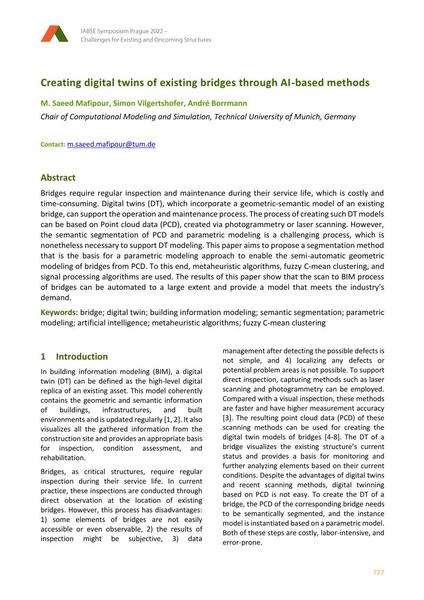Creating digital twins of existing bridges through AI-based methods

|
|
|||||||||||
Détails bibliographiques
| Auteur(s): |
M. Saeed Mafipour
(Chair of Computational Modeling and Simulation, Technical University of Munich, Germany)
Simon Vilgertshofer (Chair of Computational Modeling and Simulation, Technical University of Munich, Germany) André Borrmann (Chair of Computational Modeling and Simulation, Technical University of Munich, Germany) |
||||
|---|---|---|---|---|---|
| Médium: | papier de conférence | ||||
| Langue(s): | anglais | ||||
| Conférence: | IABSE Symposium: Challenges for Existing and Oncoming Structures, Prague, Czech Republic, 25-27 May 2022 | ||||
| Publié dans: | IABSE Symposium Prague 2022 | ||||
|
|||||
| Page(s): | 727-734 | ||||
| Nombre total de pages (du PDF): | 8 | ||||
| DOI: | 10.2749/prague.2022.0727 | ||||
| Abstrait: |
Bridges require regular inspection and maintenance during their service life, which is costly and time-consuming. Digital twins (DT), which incorporate a geometric-semantic model of an existing bridge, can support the operation and maintenance process. The process of creating such DT models can be based on Point cloud data (PCD), created via photogrammetry or laser scanning. However, the semantic segmentation of PCD and parametric modeling is a challenging process, which is nonetheless necessary to support DT modeling. This paper aims to propose a segmentation method that is the basis for a parametric modeling approach to enable the semi-automatic geometric modeling of bridges from PCD. To this end, metaheuristic algorithms, fuzzy C-mean clustering, and signal processing algorithms are used. The results of this paper show that the scan to BIM process of bridges can be automated to a large extent and provide a model that meets the industry’s demand. |
||||
| Mots-clé: |
pont Building Information Modeling
|
||||
| Copyright: | © 2022 International Association for Bridge and Structural Engineering (IABSE) | ||||
| License: | Cette oeuvre ne peut être utilisée sans la permission de l'auteur ou détenteur des droits. |
||||
